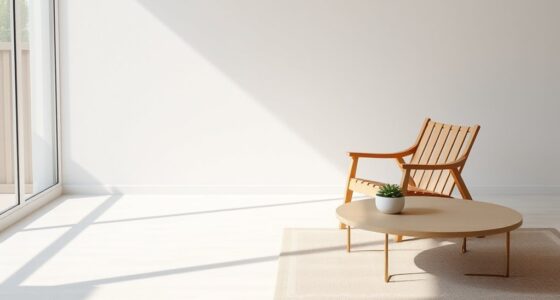When considering flooring options, wood adds warmth and elegance but can be prone to scratches and moisture damage. Tile, on the other hand, is highly durable and water-resistant, making it perfect for high-traffic and humid areas. While wood has a higher initial cost, its longevity may justify the investment. Tile often costs less to install, but its hard feel underfoot might affect comfort. There’s much more to explore about these materials and their maintenance needs.
Key Takeaways
- Wood flooring offers a timeless aesthetic but is more susceptible to scratches and moisture damage compared to tile.
- Tile is highly durable and water-resistant, making it ideal for high-traffic and humid areas.
- Wood requires careful maintenance and refinishing, while tile is easier to clean and maintain.
- Wood has a higher initial cost but provides long-term value; tile is often cheaper to install upfront.
- Consider lifestyle needs, as wood creates warmth while tile is better for pets and moisture-prone spaces.

When it comes to choosing flooring options, the variety can feel overwhelming, but you don’t have to settle for just anything. You’re likely contemplating wood and tile, two popular choices, each with its own set of pros and cons. Understanding these can help you make the best decision for your home.
Wood flooring offers a timeless aesthetic that can add warmth and elegance to any room. It’s durable, and with proper care, it can last for decades. You can refinish wood floors to restore their original beauty, which is a huge advantage. However, you should keep in mind that wood can be susceptible to scratches, dents, and moisture damage. If you live in a humid area or plan to install flooring in bathrooms or kitchens, you might want to think twice about wood. Additionally, wood flooring can be more expensive upfront, but if you’re looking for long-term value, it might be worth the investment.
Wood flooring brings timeless elegance and durability, but consider its susceptibility to moisture and higher initial costs.
On the other hand, tile flooring is incredibly versatile and comes in various styles, colors, and textures. It’s ideal for high-moisture areas since it’s water-resistant and easy to clean. If you’ve got kids or pets, tile can handle the wear and tear better than wood. The installation of tile can be more complex, though, and it may require a professional to get it right. Another thing to consider is that tile can feel cold and hard underfoot, which might not be the most inviting option for living spaces.
When weighing the pros and cons, think about your lifestyle and the specific needs of your home. If you prioritize aesthetics and warmth, wood might be your go-to. But if you’re looking for durability and easy maintenance, tile could be the better choice. You’ll also want to consider long-term costs. While wood may have a higher initial price, its longevity can make it a worthwhile investment. Tile, while often cheaper to install, might not have the same lifespan or refinishing options as wood. Additionally, the increased integration with smart home technology in security systems may influence your choice of flooring, as certain materials can complement these high-tech features.
Ultimately, it comes down to personal preference and practical considerations. By evaluating your needs and preferences, you can confidently choose the flooring that fits your lifestyle, enhancing both the beauty and functionality of your space.
Frequently Asked Questions
Which Flooring Option Is Better for Pets: Wood or Tile?
If you have pets, tile is often the better option. It’s durable, scratch-resistant, and easy to clean, making it perfect for those occasional messes. Wood can be more prone to scratches and water damage from accidents, but it has a warmer feel. If you prefer wood for aesthetics, consider sealing it properly and using rugs in high-traffic areas. Ultimately, it depends on your pet’s behavior and your lifestyle.
How Do Wood and Tile Flooring Affect Home Resale Value?
Wood flooring often boosts your home’s resale value due to its classic appeal and warmth, while tile flooring provides durability and easy maintenance. If you choose wood, you’re investing in timeless charm; if you select tile, you’re opting for practicality and versatility. Buyers generally appreciate both options, but wood might attract those seeking elegance, whereas tile appeals to the utility-focused. Your choice should reflect the market trends in your area for the best outcome.
Can I Install Wood Flooring in Bathrooms?
Yes, you can install wood flooring in bathrooms, but you should proceed with caution. Moisture can damage traditional wood, so it’s best to select engineered wood or a water-resistant finish. Make sure to maintain proper ventilation and consider using rugs to absorb excess moisture. If you’re set on wood, verify it’s suitable for high-humidity areas to avoid warping or mold. With the right precautions, wood can add warmth and style to your bathroom.
What Are the Best Cleaning Products for Wood and Tile Floors?
For cleaning wood floors, use a pH-balanced cleaner specifically designed for wood, or a mixture of vinegar and water. Avoid excess moisture. For tile floors, a mild detergent or a vinegar-water solution works well. Make sure to avoid abrasive cleaners that can scratch the surface. Always follow up with a dry mop to prevent water damage and streaks. Regular sweeping or vacuuming helps keep both types of floors looking their best!
How Do Climate and Humidity Affect Wood Versus Tile Flooring?
“April showers bring May flowers,” but they can also wreak havoc on your flooring. In humid climates, wood can swell and warp, while tile remains unaffected. Conversely, dry conditions can cause wood to crack, but tile stays stable. If you live in a fluctuating environment, consider how moisture impacts your choice. Remember, wood needs consistent humidity to thrive, while tile’s resilience can handle varying climates without a hitch. Choose wisely!
Conclusion
In the end, choosing between wood and tile flooring is like deciding between a cozy sweater and a sleek jacket; it all depends on your style and needs. Wood brings warmth and character, while tile offers durability and ease of maintenance. Consider factors like traffic, climate, and personal taste before making your choice. Ultimately, both options can enhance your space, so pick the one that feels right for you and fits your lifestyle best.









